

|
Home Updates Hydros Cars Engines Contacts Links Racing Contact On The Wire |
Jack Morgan. A true Pioneer.
It is most unusual to find unmolested cars from the very early days of tethered car racing in the UK, but two of Jack Morgan's cars from the 1940s have turned up again prompting further research to accompany original photos that had been shared with us. We are indebted to Peter Hill for most of the original material that follows.
|
|
Jack retained two of his cars until his death, along with the Lucy Gascoigne MG streamliner that he and Jack Gascoigne had built between them. At this point they vanished before one of his cars and the MG appeared on ebay in the US some while later. Since then both have changed hands more than once, but now we have photos from the current owners we are able to put together the story behind one of the pioneers of tethered car racing in the UK. Jack was President of the Retro Racing Club until his death, and in the first issue of the Club's newsletter described how he became involved with tethered cars, and his subsequent disillusionment with the way the sport had developed. We are so lucky to have this original account of how tethered car racing came into being here. What follows are Jack's own words as written, and here, in the current idiom, we have to issue a 'trigger warning'. The language and sentiments expressed are of the time and reflect the views held by many of the pioneering tethered car racers. |
|
"1939, war declared and all power model flying stopped. I had a five foot wingspan model that I had made with a Brown Junior engine, one of the first, along with Col Bowden. Having read about the cars in America with these engines fitted and aircraft landing wheels some of which were friction drive I thought, let's make a proper car with side frames, cross members all riveted in like the full size ones. To this I fitted my Brown Junior engine, friction driven, and I thought to myself, what a clever sod I am so I sent photos and an article to the Model Engineer somewhere about 1946, which they published. Three other model engineers, who read my article had also built model cars, they were (Gerry) Buck, (Jim) Cruickshank and (Bob) Curwen. Jim Cruickshank who worked at a blind factory in London which had a large flat roof wrote to the Model Engineer stating that if any modeller would like to turn up on a certain date they could run their cars on the roof. (this was 1943, not 1946 OTW) |
|
On the day mentioned, Buck, Curwen, (Jack) Gascoigne and myself turned up to join him. Cruickshank had built a model of the George Eyston MG which had a centrifugal clutch fitted to the 5cc E.T. Westbury designed Kestrel engine, this enabled him to start the engine and hold the car until releasing it. Gerry Buck's car had a Gwin engine, Whilst Curwen's had a own designed one, Gascoigne used a Hallam and myself with the Brown Junior. We all bumbled round, with Gerry Buck's car being the fastest, and for ever more after that.
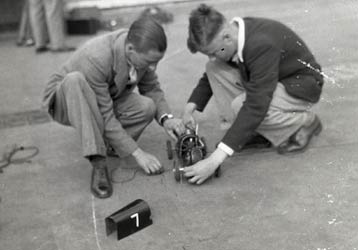 |
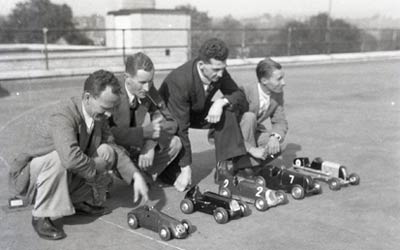 |
| Jack Morgan at the roof top meeting in 1943 | Jim Cruickshank, Bob Curwen, Gerry Buck Jack Morgan |
|
|
What happened next: We formed a club (The Pioneer Model Car Club) and held a meeting in the Royal Horticultural Hall. Following this the Aeromodeller came into it run by D.A. Russell, (who had also been at the roof top meeting with an American Bunch 'Speed Demon' seen on the right of the above photo) they owned a small aerodrome near Leighton Buzzard called Eaton Bray which had a large concrete turning circle for checking plane compasses, ideal for a race track, and from then on the movement expanded. Regular meetings were held on weekends. Left : Jack's 10cc 'Fox' at Eaton Bray in 1946 |
|
On Fridays we would turn up and stay at a hotel in Leighton Buzzard called the Black Swan and take over the hotel, high jinks and what not. Saturday we would go to the track for practice come back to the hotel at night, race on the Sunday then all go home just like the full size people. The motor trade started to give us trophies, Jaguar, Lucas, KLG. Etc. Some quite famous people came to see us race, Goldie Gardner came and stopped at our 'pit', Gascoigne and myself had built a model of his MG Midget, which he had set many records with and so I asked him if he would autograph it for us, as he did not have a pen to hand he scratched his name on the inside of the body. It is still here to this day. Right:- (well it was until a recent repaint in the US) Engraved in September 1947 |
|
|
|
Various clubs sprung up all over the country, then the Americans started to send over ready built cars, Doolings and teardrop shapes running on one wheel only, this attracted the wrong type of person they were not model engineers at all, but car salesmen etc. who bought these yank cars, put them on the track and did 90mph so slowly the Model Engineers came out of it. It finally packed up with things like the Doolings etc. being so much faster than our scale cars which featured springing fore and aft, clutches etc. A lovely hobby while it lasted." Left: The 'Pioneers' on the roof top in 1945 From Left: |
(OTW It is ironic and indicative of the disillusionment of the way that the sport had developed that every one of the 'Pioneers' seen above had moved on to other model disciplines completely by 1950. Even the most successful of those from the first meeting, Gerry Buck, retired in 1951)
Jacks Cars:
It is important to note here that photographic evidence that exists does not match up with the text from contemporary magazine reports, causing a level of confusion in preparing this article. What follows is a distillation of all the material available to us assembled in to what we believe to be the correct time line.
|
Firstly, as noted, Jack's chronology is somewhat awry as the first roof top meeting he attended was in 1943, but not with the car he described. We have this original image and basic description from his letter of his very first car with the Brown Junior motor and the car he used in 1943 was probably a more refined version of this? From what can be gleaned from photos it appeared by then to have a gearbox and clutch with the engine raised significantly giving a much more bulky car as seen in the original photos. The second roof top meeting with the Pioneer Club in attendance was in 1945 where Jack had two 10cc cars, the one from 1943 and an entirely new car. Right: Jack's first car, Brown Junior engine |
|
The second car was described in detail in an article in Model Car News December 1946 and was claimed to be a rebuild of the original car with a lightweight chassis, new bodywork and a 'gay new colour scheme'. This is clearly misreported as along with Jack, both cars can be seen side by side at the roof top meeting in 1945.
|
|
|
| Jack Morgan at left with both cars | Jack Gascoigne came to tea bringing his MG |
This 10cc car started life with an old and very worn Ohlsson Gold Seal engine that had to be modified to accommodate a new contact breaker and clutch mounting that took up the 'slack' in the crank location as there was no longer any prop thrust to do the job.
|
|
|
| New 10cc car on the roof top in 1945 | Jack left with Gascoigne right |
|
The article is fully detailed, but of note was that the radiator was part of an old gear case, cut and shaped, the wheels machined from the solid and the tyres were rubbers obtained from the steering column of an AEC London bus as on his first car. Jack was a maintenance engineer with London Transport, hence the use of bus related items. Interestingly he describes the car as being painted 'dark blue' and not having tried the car, yet here it is a year earlier, so again, the time line is a bit skewed. Over time the Ohlsson was replaced with an OK 60 and the colour from blue to its now red, probably in the winter of 1945/46, gaining the 'Red Fox' name. It was described as 'new' at the indoor Eaton Bray meeting in November 46, but had clearly been in existence for over a year. Jack used this car regularly at the BMCC meetings as he described in his notes where it was consistently around 51-52mph with the OK. Contemporary reports also mention the very 'social nature' of the after race activities. Right:- 1945 roof top meeting, Jack with 'Fox' beside Bob Curwen and the Curwen Special |
|
Jack's next venture over the winter of 1946 was a 5cc car that was very similar in design to the previous 10cc 'Fox'. The motor in this was a much modified Westbury design built by Jack, driving through a clutch and gearbox to the front wheels, again machined from the solid but sporting Dunlop tyres as used on the M&E cars. This car was called 'Vixen' to continue the name theme. 'Vixen' achieved a degree of success at meetings, including taking the Eaton Bray 5cc 1 mile record at 44mph
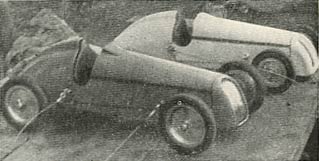 |
|
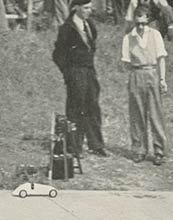 |
| 'Fox' and 'Vixen' at Eaton Bray, Whitsun 1947 | ||
It might seem strange now, but much of the early running in the UK was carried out indoors as in the Horticultural Halls. Other venues included works canteens, garages and even a social club. This enabled meetings throughout the winter to be a regular fixture as with the Pioneer, Meteor and Edmonton Clubs. Most of these ran on very short cables, Meteor's being just 13 feet. 'Vixen' was just under 40mph at the February 48 meeting in the Rego works canteen. Even then some indication of the way the sport was fragmenting was obvious as 'foreign engines' were banned at these events.
|
|
|
'Vixen' on the steps of the Royal Horticultural Halls Photographed by Edgar Westbury |
Photos below show Jack running this car in May 1947 at the inaugural meeting of Surrey Club on the delightfully named Christmas Pie track, Normandy near Guildford. The flag on the side of the track was to activate the fuel cut-offs, somewhat safer than using a cap or towel.
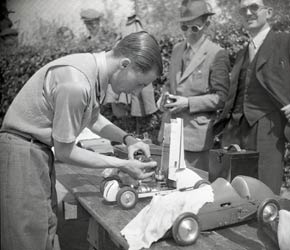 |
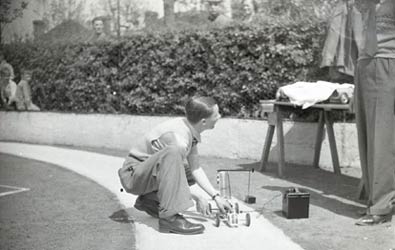 |
|
Jack with 'Vixen' at the Surrey Club's track, Christmas Pie. |
|
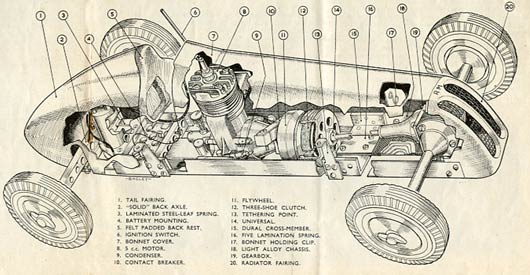
Layout of 'Vixen' in a detailed article on the car in Model Cars for November 1947
|
Jack's last car appeared in 1948, another 10cc of similar design to the previous models, but this time with a McCoy motor, ZN pneumatic wheels and tyres. Continuing the Fox theme, this car was called 'Cub'. It was run at the Eaton Bray Whitsun meeting in both the Austin and Russell Trophies. In the Austin it recorded 76mph but in the Russell it was up to 81mph. However the sparks were provided by magneto that flexed so much that it regularly demagnetised. Right: 'Cub' with ZN wheels. Note 'kickboards' to protect the pit area. |
|
Following his retirement from running tethered cars Jack married and moved from Greenford to Wimbledon, which necessitated giving up his workshop facilities, but his interest in modelling took a new turn with model boats especially following his final move to rural Norfolk. A trawler and coaster were followed by a large destroyer powered by a Mills 2.4cc diesel that he had converted to glow plug ignition.
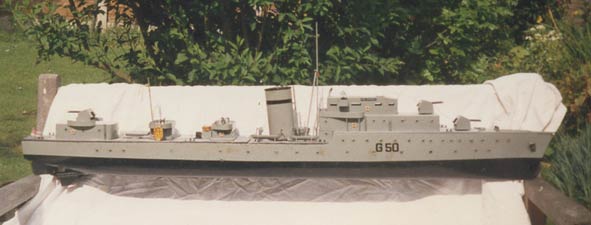
Jack was also involved with Jack Gascoigne in building the Gardner MG that Lucy Gascoigne used so effectively. This had a horizontally mounted Westbury Kestrel motor. Gascoigne was another of the Pioneers who had become disenchanted with the route that tethered cars were taking so retired from the sport and became involved in rail racing and early radio control yachting, passing the MG to Jack for safe keeping.
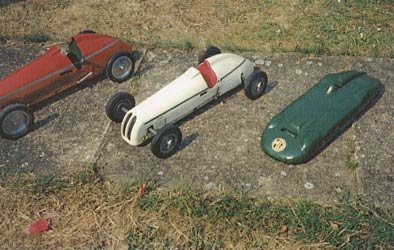 |
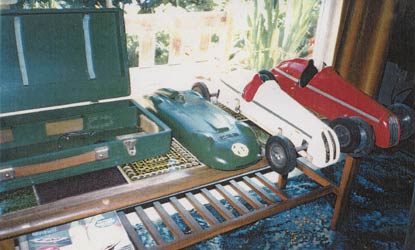 |
| 'Fox', 'Vixen and Lucy Gascoigne's MG photographed by Jack | |
Jack was in regular contact with Peter Hill of the Retro Club and had informed him that the cars would remain in his family for posterity, despite annual attempts by Miquel de Rancougne to buy them with ever increasing offers. It was a great surprise then to see the MG and 'Vixen' appear for sale in the USA on ebay. They, along with the destroyer' had been spotted in a second hand dress shop in South London by a tourist from the US, but how they got there is still a mystery. He put them on ebay where they sold for modest amounts, the prospect of hefty import duty negating any interest from the UK. The MG passed through the late Ron Reiter's hands who sent us photos back in 2012.
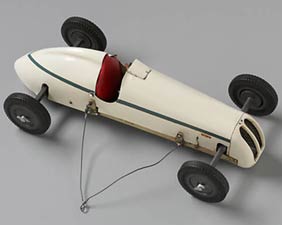 |
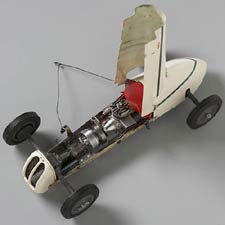 |
 |
| 'Vixen' still in original condition as raced | Jack with MG, 'Vixen' and 'Fox' | |
'Vixen' had effectively disappeared until 2024 when the new owner contacted us with photos. It had returned to the UK and was in exactly the same condition as when photographed back in the 1940s. Similarly, 'Red Fox' had also vanished until 2014 when Peter Hill was contacted by a relative of Jack's who had inherited the car with precise instructions of who to contact if he wanted to sell it. Remarkably, when it arrived in Lincolnshire the car was in an equally original condition and still had the original, ex London Transport, tyres.
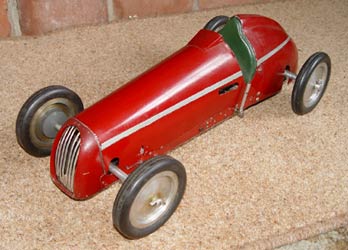 |
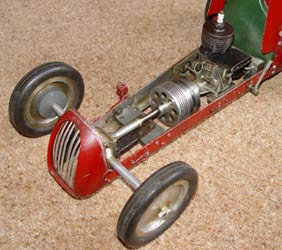 |
| 'Red Fox' as run in the 1940s still with original rubber tyres | |
Coincidently, both the Fox and Vixen are now owned by Peters but the MG has again vanished. Luckily, we have a number of original photos of Jack and his cars from the Westbury archive whilst Peter Hill has also passed us photos he received from Jack of the cars in the 1990s.
We are indebted to Peter Hill for the bulk of the information above and original material from the Retro Club archives. Thanks also to him and Peter T for photos of the cars as they are currently. Can anyone help with the location of the Gascoigne MG, Cub or destroyer please?
ęcopyrightOTW2025